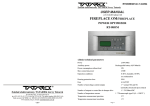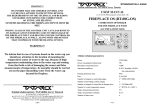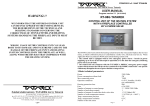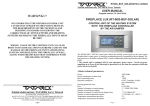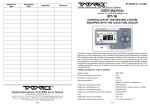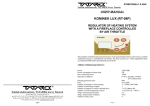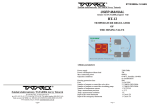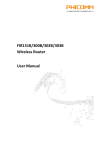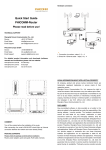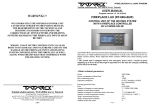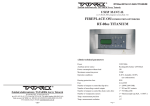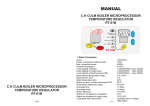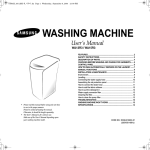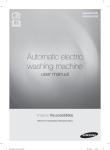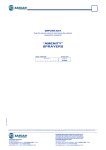Download STOVE /OM
Transcript
Admission date Realization date Signature RT08OM-GRAF/2015/v.1.01/ANG Remarks Zakład elektroniczny TATAREK Jerzy Tatarek USER MANUAL v.1.0 (20.02.2015 software from v1.01) STOVE OM/ STOVE POWER OPTIMIZER CONTROLLER RT-08 OM GRAFIK Zakład elektroniczny TATAREK Jerzy Tatarek 50-559 Wroclaw, 75 Swieradowska st. ph. (071) 367-21-67, 373-14-88, fax 373-14-58; Tax index number 899-020-21-48; Bank account: BZ WBK S.A. WROCLAW 6910901522-0000-0000-5201-9335 www.tatarek.com.pl.; E-mail: [email protected] 24 !!!! WARNING !!! IF USING THE SEALED AIR DAMPER YOU HAVE TO CHECK IF THE DESIGN OF THE STOVE INPUT ENSURES A SUFFICIENT AIR SUPPLY, WHICH IS NECESSARY FOR THE COMBUSTION OF GAS THAT IS INDUCED DURING THE WOOD BURNING (SECONDARY COMBUSTION). IN CASE THE STOVE INPUT DOESN'T GUARANTEE THE EXTRA AIR SUPPLY (THAT IS, IT'S SEALED) THE USING OF THE SEALED AIR DAMPER IS FORBIDDEN BECAUSE IT CAN CAUSE AN EXPLOSION OF GASES DEVELOPED DURING THE WOOD BURNING. 1 Contents: WARRANTY 1.: : : Basic technical parameters.............................................................................................. 3 2. Principle of operation..................................................................................................... 4 3. Informations on the installation of the controller .......................................................... 5 3.1 Recommended connection cables and rules of safe installation of the controller....................................................................................................................... 5-6 3.2 : Connection of the controller- wiring diagram ................................................................7 4.: : : Operation of the controller - operation phases................................................................ 8 4.1 : Temperature sensors....................................................................................................... 8 1.Warranty is valid [24] months from the date of sale. 2.Producer does not take responsibility for any mechanical damages made by user. 3.MAKING REPAIRS OR MODYFYING THE DEVICE BY USER IS FORBIDDEN AND CAUSES WARRANTY CANCELATION 4.Warranty card is valid only with date of sale, seller's signature and stamp 5.Warranty and after-warranty repairs should be done only by producer, damaged regulators should be sent to producer in order to make all repairs needed. 6.Warranty protection includes the EU 7.Warranty does not exclude, not restrict and not suspend buyer’s rights coming from the incompatibility of the article with the agreement (Laws Journal No. 141 Pos. 1176) 4.2 : Power of the stove.......................................................................................................... 8 4.3 : Air damper...................................................................................................................... 8 WARNING ! 4.4 : Increasing the chimney draught................................................................................... 9 ANY MODIFICATION OF THE CONTROL UNIT MADE BY A USER CAN BE THE CAUSE OF SAFETY CONDITIONS DETERIORATION AND CAN EXPOSE THE USER TO ELECTRIC SHOCK OR DAMAGE DEVICES SUPPLIED. 4.5 : Additional functions of the controller........................................................................... 11 5.: : : Handling the controller - main panel............................................................................ 11 5.1 : Alarm screen................................................................................................................. 12 5.2 : Screen of AUTOMATIC operation of the furnace........................................................ 13 Connection cable of the control may be replaced only by producer or his authorized service locations 5.3 : Screen of MANUAL operation of the furnace.............................................................. 14 5.4 : Screen of combustion history........................................................................................ 15 5.5 : Information screen........................................................................................................ 15 5.6 : Screen of setting the parameters................................................................................... 16 6.: : : Change of the controller settings - parameters of the settings...................................... 17 7.: : : Remarks of the producer............................................................................................... 21 WARNING! 1. Producer does not take the responsibility for damage caused by atmospheric discharge 2. and overvoltage in the mains 3. Burnt fuses are not subject to warranty replacement CE Conformity Declaration................................................................................................... 22 Warranty................................................................................................................................. 23 Date of sale Seller's signature and stamp ARGO-FILM Recycling Plant No. 6 180 Krakowska st., 52-015 Wroclaw Worn out electronic and electric devices must be transfered to ph.: 071 794 43 01, 0 515 122 142 the utilization collection place, where will be accepted for free Register No.. GIOS: E 0002240WZ Zakład elektroniczny TATAREK Jerzy Tatarek 2 50-559 Wroclaw, 75 Swieradowska st ph. (071) 367-21-67, 373-14-88, fax 373-14-58; tax index number 899-020-21-48; Bank account : BZ WBK S.A. O/WROCŁAW 6910901522-0000-0000-5201-9335 www.tatarek.com.pl.; E-mail: [email protected] 23 1.Basic technical parameters Power CE CONFORMITY DECLARATION Ref. No. 58.RT.01.2007/1/B We, ZAKŁAD ELEKTRONICZNY TATAREK Jerzy Tatarek 75 Swieradowska St. , 50-559 Wroclaw 230V/50Hz Auxiliary power Rechargeable battery 4,8V/60mAh Power consumption without load 5W Maximum connection power 250W Operation conditions 0-40 oC, humidity 10-90% no condensation declare under our sole responsibility that Housing protection class IP41 the following controller: STOVE POWER OPTIMIZER CONTROLLER Fuse 6,3A/250V model: RT-08 OM GRAFIK Number of control outputs of the flap drive or is in conformity with the basic requirements included in Directive EMC 2004/108/WE of 15.12.2004 (the electromagnetic compatibility law of 13.04.07) and Directive LVD 2006/95/WE of 21.08.07 (Laws Journal of 2007 No. 155 pos. 1098) regarding the requirements for electric devices. To the conformity evaluation the following harmonized standards were used: draught generator 1*250W/230V/50Hz Number of nonvoltage control outputs 1 * switched contact Number of outputs to control the air damper drive 1 * 5V/500mA/DC o Number of temperature sensors PN-EN 60730-2-1: 2002 - PN-EN 60730-1: 2012 PN-EN 55022: 2011 - Automatic electric control units for house usage and the like. Part 2-1: Specific requirements regarding electric control units for electric house devices Automatic electric control units for house usage and the like. Part 1: General requirements. Electromagnetic compatibility (EMC)- IT devices Characteristics of radioelectric noises. Acceptable levels and measurement methods Electronic Engineering Plant TATAREK has initiated management system and complies with the following standard : ISO9001: 2000 CERTIFICATE No. 133/2004 of 01.2004 Polish Foreign Trade Chamber The last two digits of the year in which the CE marking was affixed: 12 Place of issue: 1 * Thermocouple type K (0...+1300 C ) o Temperature measurement precision 5C Temperature measurement resolution 1C o Equipment of the controller The controller is available as a full set guaranteeing a complete operation of the furnace. The set includes: - Control module Mask frame Dedicated cold air damper with the seal (available in 3 diameters: 100, 120 and 150mm) Main temperature sensor of the flue gas( thermocouple) Optionally you can connect up additional devices: - Support temperature sensor of the flue gas ( thermocouple) Sensor of opening the furnace door ( reed relay ) Dedicated CO concentration sensor with feedback signal Generator of the chimney draught or a servo of the chimney flap drive Manufacturer representative: Wroclaw Mirosław Zasępa Date of issue: Position: 17.09.2012 Electronics designer 22 3 2. Principle of operation Examples of passwords: The RT-08 OM GRAFIK controller is used to control the combustion process and maintaining the embers phase as long as possible by controlling the air damper that channels air to the combustion chamber. Thanks to lowering the combustion curve during the phase of temperature increase , its stabilization at the preset level and its raising during the phase of temperature decrease at the end the controller extends the combustion process. The most important advantage of this model of the optimizer is the capability to choose one of 3 power programs 1,2,3 of the furnace (minimum, average and maximum power) and to select an optimal temperature of operation in view of atmospheric conditions . Thanks to that it's possible to achieve out of a given portion of fuel an optimal portion of energy, which allows to raise functionality economy of the furnace. The operation of the RT-08 OM GRAFIK controller begins at the moment that the furnace door closes (the door sensor D1) or in case of no sensor with the button on the front control panel. The combustion process starts, controlled by the flue gas temperature sensor T1 that manages the air damper which supplies air to the furnace. When the firing-up phase ends the air damper is gradually closed and runs periodically maintaining the preset power range at the constant level. At the time of a decrease of temperature (the input burns out) the air damper is being gradually closed to maintain the furnace temperature as long as possible. When the embers phase in the furnace is reached the air supply is cut off, interrupted by scavenges in order to get rid of flue gases from the combustion chamber. In alarm situations (also power declines) the air damper is opened that enables the full burnout of the fuel input. The special input to cooperate with an external CO detection sensor improves the safety of even the most sophisticated heating systems available. Advantages of the combustion optimization controller: -limiting the maximum combustion temperature -capability of choosing optimal stove power for the user -extending the combustion process -limiting the maximum temperature of the furnace -decreasing fuel consumption -extending the exploitation time of stove inputs -shutting off air supply after ending the combustion (preventing the stove and room cool-off) -cooperation with CO sensors (opening up the fresh airing of the combustion chamber in emergency) -optimal controller for operating the gravitational heat distribution and HOT AIR DISTRIBUTION systems and accumulation rings ! 1.The controller is installed with the unlocked password. The user can enter his own password e.g. “1234”. From this moment the important parameters cannot be altered without the password being unlocked (that is, resetting the password “1234”). After changing essential parameters the user can leave the controller unlocked, set any new password or enter “9999”, which activates the password “1234” 2. Producer gives the controller with the set password. The user cannot alter the important parameters. The service can change the settings with its own secret password. At the end a serviceman enter the secret password or “9999”, the user still hasn't access to the important parameters. 3. Producer gives the controller with the set password. The user cannot alter the important parameters. The service can change the settings with its own secret password. At the end a serviceman leaves the controller unlocked, the user now has access to the important parameters. He can enter his own password like in example No. 1. 4. Producer gives the controller with the set password. The user cannot alter the important parameters. The service can change the settings with its own secret password. At the end a serviceman sets the password e.g. “1234” and tells it to the user, the user has access to the important parameters but without knowing the password the other persons cannot make the changes. 5. The user has the unlocked controller or his own password. Serviceman decides, the user though oughtn't have access to the important parameters. The serviceman locks the controller with his secret password, which removes the user's password and locks the controller. 6. Serviceman doesn't have to know the user's password. Always he can use his own secret password and at the end lock with the “9999”, which reactivates the user's password. 7. REMARKS OF THE PRODUCER ! ! ! PRODUCER OF THE CONTROLLER IS NOT RESPONSIBLE FOR DAMAGES CAUSED BY WRONG USAGE AND IMPROPER CONNECTION OF THE CONTROLLER, ITS MACHANICAL DAMAGE AND DAMAGE OF PERIPHERAL DEVICES THAT COOPERATE WITH THE CONTROLLER. THE PRODUCER IS NOT RESPONSILBE FOR DAMAGES CAUSED BY EXTERNAL FACTORS (MAINS OVERVOLTAGES, ATMOSPHERIC DISCHARGES) ! ! ! The controller can control the stove without any door sensor In that case the button START found on the front panel is used. 4 21 Mode K1 1…5 1 51 Temperature of switching over K1 (for Moritz flap) Time K1 (for draught generator) Type of door sensor 200..1000 oC 700 oC 0…20 min 1 min 1…2 1 Relay CONTROL Manual mode permit P.Err 1…1 1 OFF/ON ON 20..100% 100% 52 12 16 17 18 No Name 90 91 Product No. Reset 92 99 1 OFF PASSWORD OFF/ ON 0…9999 Service screen OFF/ ON 0000 OFF T2 Increase of the chimney draught K1 (see ch.2.5) 1..3 Moritz flap 4 Draught generator 5 Ventilation Combustion temperature that switches over the bypass flap. Switch-on of the HEAT ACCUMULATION MODULE (for option <50>=1…3) (see ch.2.5) Operation time of the draught generator after closing the furnace door (for option <50>=4) (see ch. 2.5) ACCUMULATION RINGS STOVE 1 Open-circuited sensor (at the closed door the D1 contact is open) or lack of the door sensor 2 Close-circuited sensor (at the closed door the D1 contact is closed) Switch-on of the CONTROL relay if 1 Alarm condition occurs Switch-ON/OFF of the MANUAL operation STOVE Opening level of the air damper at power failure PARAMETERS LEVEL 4 PARAMETERS CAN BE CHANGED WITH UNLOCKED PASSWORD DEFAULT Range SETTING 0…n CHIMNEY 50 CHIMNEY No PARAMETERS LEVEL 3 PARAMETERS CAN BE CHANGED WITH UNLOCKED PASSWORD DEFAULT SETTING Name Range FUNCTION Numer of the parameters set – it depends on stove producer Setting the value to ON reverts all the parameters to their defaults and then the restart takes place. „0000” UNLOCKED PASSWORD „----” LOCKED PASSWORD Setting the value to ON causes the service screen for diagnostics to appear. ! The parameter number plays a supporting role to exactly identify the name e.g. for different lanuguage versions. Password The changes of important parameters are possible only at the unlocked password. To unlock the password you need to input a proper sequence of digits with the buttons “ “. With the button “CHOOSE” to change the digits position and OK button (6) to acknowledge all and finish the procedure of changing the password. The unlocked password is set to “0000”. Once again entering into the password change procedure causes a new password to be set. ! PASSWORD „9999” HAS CONSIDERABLE MEANING. IT CAUSES THE REACTIVATION OF THE PREVIOUS PASSWORD IF PRESENT WITHOUT IT BEING EXPOSED. ! PASSWORD OF PRODUCER'S SERVICE IS UNIQUE AND IS NOT DEPENDENT ON THE USER'S PASSWORD- IT SHOUDN'T BE EXPOSED TO THE USER. INSTEAD OF THAT THE SERVICE CAN SET TO THE USER HIS OWN PASSWORD 20 Fig.1 Overview operation diagrams of the controller T1T2D1PPK1- Temperature sensor of the combustion Support temperature sensor (option) Sensor of opening the furnace door (option) Controlled air damper Flap drive of the chimney draught (option) 3. Informations on the installation of the controller For the proper installation you need as follows:: screwdriver with electric insulation 2,5 mm with the flat tip screwdriver with electric insulation 2,5 mm with the cross tip no.0 Handy might be: pliers with thin tips and electric insulation of the handles 3.1 Recommended connection cables and rules of safe installation of the controller - power supply cable: stranded wire 3 x 0,75 mm² cable of the air damper: 3 x 0,5 mm² default length: 3 m (it’s not recommended to extend the cable) cable of the flap servo 230V: stranded wire 3 x 0,75 mm² cable for connecting to the CONTROL contact : 2 x 0,5 mm² ( its length can be extended ) thermocouple sensor: diameter of the jacket 3,2mm, cable length-3m Extending the cable of the thermocouple sensor is forbidden and if that’s really necessary then you have to buy an extension cable with the connector of proper parameters or the whole cable with the sensor of the proper length ! 5 The installation of the controller should be carried out with care, taking into consideration safety rules (electric device) and being very cautious while screwing down the contacts of the connection block of the controller during wiring the cables so as not to lead to their mechanical damage as an effect of using too much force. The sensor of the thermocouple has a laser-made marker on the external jacket that indicates the maximum depth of the installation into the element, in which the temperature measurement will be made !!! PARAMETERS LEVEL 2 PARAMETERS CAN BE CHANGED WITH UNLOCKED PASSWORD No 20 Name MAX temperature of stove Range 400..1300 oC DEFAULT 800 oC 21 Air damper for T.MAX delay of regulation start RESTART temperature 5…50 % 10 % 1…30 min 1 min 10…1250 oC 45 oC Time of 1…10 transition to min F0 (STOP) Temp. of 50…1250 oC transition from F2 to F3 Stove temp. 50…1250 oC for power P1 Stove temp. 50…1250 oC for power P2 Stove temp. 50…1250 oC for power P3 Maximum 10…200 oC increase of stove temp. Condition of -10…-300 oC transition to F4 Time of 1…10 min transition to F4 Temp. of 50…1250 oC transition to F5 Timespan of 1…60 min F5 Timespan of 0…10 min F6 (scavenge) Air damper 0…100 % MAX F3 for power P1 Air damper 0…100 % MAX F3 for power P2 Air damper 0…100 % MAX F3 for power P3 Air damper 0…100 % MIN F3 for power P1 Air damper 0…100 % MIN F3 for power P2 Air damper 0…100 % MIN F3 for power P3 Air damper 0…100 % for F5 1 min 22 23 Wrong mounting of the sensor may lead to its premature failure !!! 24 IMPORTANT! Before installing the controller you must make sure if the safe power supply is delivered to the building, though if the power supply is a temporary “construction” one you must remember -if you switch it over to the right voltage- about disconnecting the voltage cables from the controller !!! 26 30/1 30/2 GROUND CABLE HAVE TO BE CONNECTED TO THE CONTROLLER!!! 30/3 32 !► The controller should be located close to the stove so as to offer a continuous overview of parameters in terms of the operation of the system and thanks to that a fast indication of any failure of the system. 34 36 !► In order to protect the controller against too high temperatures around the stove input the controller should not be mounted in the casing itself of the stove except for places intentionally prepared in terms of temperature protection. Too high temperature of the ambience of the controller might eventually lead to the deterioration of the life of some components and therefore to their premature failure. 38 39 40 !► The air damper shouldn’t be mounted closer than 1 m from the air inlet to the inflow channel on account of protecting it against too high temperature. !► Before installing all the equipment you have to leave the revision openings in the casing of the stove itself, which ensure a simple access to the peripheral devices of the controller (cold air damper (PP) and temperature sensors T1 and T2). It allows in the future to cyclically check the state of the air damper’s wing and a simple access to the temperature sensor in case it failed or was damaged. 42/1 42/2 42/3 43/1 43/2 43/3 44 6 SETTING FUNCTION Maximum temperature of the stove T1. After reaching it the sound alarm turns on and the air damper closes to the extent determined by the <21> parameter. The seeting 1300oC indicates this parmeter control is disabled. The opening level of the air damper if the temperature exceeds the <20> parameter Delay of regulation start (timespan of the F1 phase) 400 oC Restart temperature after switching on the power. If after the power switch-on of the controller the furnace temperature is above the <24> parameter then the automatic start occurs (transition to F1) After this time the transition to the standby phase F0 follows if the temperature determined by the <23> parameter is not reached End temperature of the F2 phase 250 oC Temperature of the F3 phase at power =1 o Temperature of the F3 phase at power =2 o 350 C Temperature of the F3 phase at power =3 50 oC Maximum temperature increase of the F3 phase -30 oC Temperature drop relative to F3. It indicates the F4 start 2 min Time of the condition <34> required for the F3 phase to finish and then the transition to F4 follows. 150 oC Temperature of the F2 phase start 10 min Timespan of the F5 phase 1 min Timespan of the F6 phase. Scavenge time. The air damper opens up and the flue gases are burned. 60 % MAXimum opening level of the air damper at phase F3 at power=1 65 % MAXimum opening level of the air damper at phase F3 at power=2 70 % MAXimum opening level of the air damper at phase F3 at power=3 10 % MINimum opening level of the air damper at phase F3 at power=1 10 % MINimum opening level of the air damper at phase F3 at power=2 10 % MINimum opening level of the air damper at phase F3 at power=3 5% Opening level of the air damper at the beginning of the F5 phase 300 C 19 No Name Range DEFAULT 10 Sound signals OFF/ ON/ ON+ ALARM ON+ ALARM 11 Language 13 LCD Backlight 14 15 LCD minimum backlight Registration time Polish/ english/ … OFF/ ON Polish 0…25% 10% 1…6 hr. 2 hr. SETTING CHIMNEY 3.2 Connection of the controller- wiring diagram PARAMETERS LEVEL 1 FUNCTION OFF Button „click” disabled Alarm sound disabled ON Button „click” enabled Alarm sound disabled ON+ ALARM Button „click” enabled Alarm sound enabled OFF+ ALARM Button „click” disabled Alarm sound enabled Language of the messages OFF STOVE OFF- Backlight is enabled for 2min since pressing any button ON- Backlight is permanently enabled if the controller is on. Turning off the backlight indicates it assumes the value of the <15> parameter Minimum level of the backlight (it has significance for the negative LCD. The value “0%” indicates the full switch-off. Registration time of the combustion process history (At 1hr. temperature registration every 40sec. At 2hr. every 2*40sec. and so on) red yellow(blue) black PP Air damper Door sensor FUSE white green white green MAINS Fig.3 Wiring diagram T1- Main sensor of the combustion temperature. Thermocouple type K (the wire of higher potential is green, of lower one is white) T2- Additional temperature sensor. Thermocouple type K (the wire of higher potential is green, of lower one is white). Extra sensor that indicates temperature at any point without affecting the algorithm of the controller’s operation. (option) PP- Electronically controlled air damper TATAREK D1- Sensor of opening the furnace door (option) The type of sensor is determined by the parameter "<12> Type of Door Sensor" -in case of the short-circuited sensor (at the closed door the terminal D1 is short-circuited), set <12>=2. -in case of the open-circuited sensor (at the closed door the terminal D1 is open), set <12>=1 -lack of the door sensor, leave the terminal D1 disconnected and , set <12>=1 or short the terminal D1 and set <12>=2. K1- Flap drive of the by-pass of the heat accumulation module or draught generator (option) X3- CO concentration detector The input “+” has higher potential (it's important for Open Collector Systems). The schort-circuit of the contacts means the exceeding of permitted CO concentration. At the lack of CO control, leave the contacts disconnected.(option) 18 7 4. Operation of the controller - operation phases The controller controls the combustion process in the following cycle: 1. F0/STOP - The standby phase. The controller awaits opening of the door and preparing of the fuel for the next burning. In the STOP state the air damper is closed. 2. F? - The transient phase. After powering on the controller waits for stabilization of conditions and decides if to go to the F0 phase (if the furnace is burnt out) or to the F1 phase (if the furnace is fired up). In the F? state the air damper is open. 2. F1 - The start phase. After loading the fuel and its lighting you close the furnace door. It's a signal for the controller that the combustion cycle has begun. The air damper is fully open. 3. F2 - The firing-up phase. After reaching the limit temperature and warming up the stove the transition to the phase F3 follows. 4. F3- The combustion phase. Stabilization of the combustion temperature depending on the chosen power of the stove F4 - The phase of temperature decreasing . The air damper is again gradually closed 5. F5 - The embers phase. Signalling the demand for replenishing the fuel 6. F6 - The phase of removing the furnace gases. The air damper first opens up and then closes and there's the transition to the standby phase. 6. CHANGE OF THE CONTROLLER SETTINGS After switching on the controller it will operate on averaged defaults that are indicated in the tables of parameters settings. The tables also include the most important data for the user of the controller The change of any parameter is done with the 4 buttons on the main panel of the controller and if you want to alter the chosen parameter from the table you need to follow the following tips: 1. 2. 3. 4. 5. 6. 8. You confirm the intention of changing this parameter by clicking the CONFIRM button, and then the digit readout, which indicates the temperature of this program , starts blinking (the default 250oC) You change this parameter with the buttons The digit will be blinking all the time. You confirm the change with the CONFIRM button 9. The changed paramater has been stored in the memory of the controller. ► The controller can control the furnace without the door sensor. In that case the buttons of the control panel are used. 7. 4.1 Temperature sensors Temperature sensors are thermocouples type K which can measure temperature from 0oC to 1300oC (depending on the design). The temperature sensor of combustion T1 should be mounted on the upper part of the furnace (unless the producer delivered a place where such a measurement can be made or above the output of flue gases from the furnace). The T2 sensor (optional equipment) monitors temperature at any location of the system, e.g. temperature of the accumulation mass. You click the CHOOSE button until the PARAMETERS LEVEL screen along with the value “0” shows up You confirm the intention of altering the parameters with the CONFIRM button, then the value “0” begins blinking. You click the + button several times depending on the parameter you want to change. The double click transitions you to the second level. The digit “2” begins blinking. The selection of the chosen level of the parameters must be confirmed by the CONFIRM button. The digit “2” lights steadily. By clicking the CHOOSE button you go through the parameters and values of the chosen level. For example if you want to change the power for the first program P1-by changing the temperature for this program - you click repeatedly the CHOOSE button until the description of the needed parameter appears (in this case “Stove temp. for power P1”) Analogously you perform the change of any parameter accessible to the user and depicted in the tables that are the most important part of this user manual. 4.2 Power of the stove The user himself decides about the heating power of the stove. There're 3 power levels: 1(minimum)/2/3(max) with which the corresponding parameters of the burning phase F3 are connected. At the beginning of using the controller it's advisable to write each change of the chosen parameter into the blank column of the table next to the corresponding parameter. It's gonna help in the future in choosing optimal settings in view of the system that is supplied in your building. 4.3 Air damper The air damper is mounted on the inlet of cold air to the combustion chamber. The position of the air damper wing is calculated by the controller depending on the combustion process. The change of the position is realized by the drive of the air damper in 20sec.cycles. The air damper can run at any position. It can be mounted either vertically or horizontally. ! In the power-off state (also a decay of the mains voltage) the combustion process is not monitored. In order to prevent the CO density increase (poisonous gas) when the partial combustion is reached before attaining the embers phase, the air damper shuts completely . 8 17 5.6 The screen of setting the parameters 4.4 Increasing the chimney draught Normally the level of parameter setting (Menu) equals to “0”, which means the parameters aren’t available. After changing the level to “1”, “2” ,”3”, or "4” the successive screens show the values of parameters. The last screen displays “****” and then the setting ends and the previous described screens follows. During normal operation the flue gases flow through the heat accumulation module (MAC) where they cool off by emitting heat. During the firing-up phase, when the chimney is cold, its draught can be insufficient..The controller can control with the K1 output the system of increasing the chimney draught . To this output you can connect the draught generator or mechanical ventilation. Depending on the applied actuator and the <50>parameter (Mode K1 ) we've got the following possibilities: Parameter name Version 1: ON MAC- HEAT ACCUMULATION MODULE Parameter <51> Unit OFF (MAC) Upper and lower limit of changes Time Parameter value (change with +/-) !!! THE PARAMETERS ADJUST THE CONTROLLER TO THE PROPERTIES OF THE FURNACE. THEIR CHANGE SHOULD BE CONSULTED WITH THE PRODUCER OF THE FURNACE AND INSTALLER WHO IS RESPONSIBLE FOR INSTALLING THE FURNACE AND STARTING THE HEATING SYSTEM The <50> parameter (Mode K1)=1. In the rest state the K1 output is turned off.The flap is directed at the MAC. The start of combustion switches on the K1 output and diverts the flue gases directly to the chimney. After reaching the preset temperature (the <51> parameter) the flap is switched off and it diverts the flue gases to the MAC. Version 2: ANY INCAUTIOUS CHANGES CAN CAUSE AN UNSTABLE AND INEFFICIENT OPERATION OF THE SYSTEM.AND IN EXTREME CASES THEY MIGHT LEAD TO ITS FAILURE!!! K1 ON (chimney) K1 ON (chimney) Parameter <51> OFF (MAC) 16 Time The <50> parameter (Mode K1)=2. In the rest state the K1 output is turned on.The flap is directed at the chimney. After reaching the preset temperature (the <51> parameter) the flap is switched off and it diverts the flue gases to the MAC. After the combustion end the K1 output is switched on. The flap is again directed at the chimney. 9 Version 3 5.4 Screen of combustion history. MAC- HEAT ACCUMULATION MODULE ON OFF OFF (chimney) chimney This screen shows the history of combustion. The screen isn't visible if the stove operates in the manual mode "MANUAL". The start of the registration follows with the start of the phase F1 and the end of the registration after the F6 phase. The temperature is registered for the time o determined by the <15> parameter. The start of the registration begins from the temperature 0 C, which constitutes a marker of a new cycle of combustion (see fig. below). Every pause of the combustion cycle and its restart (whether manually or through the door sensor) places a new marker of the new combustion cycle on the curve Time The <50> parameter (Mode K1)=3. In the rest state the K1 output is turned off.The flap is directed at the chimney. After reaching the preset temperature (the <51> parameter) the controller switches on the K1 output, causing diverting the flue gases to the MAC. After the combustion end the K1 output is switched off. The flap is again directed at the chimney. Combustion temperature Current combustion cycle Version 4 Previous cycle of combustion ON With the CHOOSE button. OFF Time Marker of new cycle you go over to the next screens. 5.5 Information screen This display informs about the state of devices connected to the controller Time The <50> parameter (Mode K1)=4. A fan of the chimney draught generator is connected to the K1 output. The generator switches on when the stove door opens (the door sensor is required) and switches off after 1min (the <52> parameter) from the time when the door closes. Version 5 Settings number Sound signal of alarm ON=switched on Door sensor OFF=open F1=switch-on/off of sound signal of alarm Relay CONTROL (ALARM) OFF=switched off K1 ON K1 OFF Time CO sensor OFF=no danger Time The <50> parameter (Mode K1)=5. A ventilation is connected to the K1 output. The ventilation switches off when the stove door opens (the door sensor is required) and switches on after 1min (the <52> parameter-”TimeK1”) from the time when the door closes. 10 By pressing the CHOOSE button Type of the circuit 1..3=MAC 4=draught generator Chimney draught ON=switched on (7) you go over to the next screens.. 15 5.3 Screen of MANUALoperation of the furnace The transition to the MANUAL mode -(the status LED diode (1) blinks)-enables taking control of the combustion process. The air damper opens up 100%. From this moment you can manually control the air damper: the button causes shutting (1 step/10%) and the button causes its opening. With the button you can cyclically change the controlled circuit to: switching on the circuit that increases the chimney draught, relay CONTROL/ALARM and once more the air damper. The selected circuit blinks on the display. Same like for the air damper with the button you switch on and with the button you switch off the selected circuit. 4.5 Additional functions of the controller !An external device controlling CO concentration can be connected to the controller. In case of detecting the danger the air damper (PP) opens up improving the ventilation of room, additionally the signal alarm switches on. ! The controller switches on the ALARM output in case of a failure of the temperature sensor of the furnace (T1) or exceeding the CO concentration. ! The capability to make use of the nonvoltage contact for either the optional drive of the K1 chimney flap or the generator of the chimney draught. ! In the MANUAL mode you must not fully close the air damper before reaching the embers phase, because there's real danger of increasing CO concentration !!! 5. Handling the controller - main panel ! In the MANUAL mode you must not fully close the air damper before reaching the embers ON/OFF phase, because there's real danger of increasing the wood gas, which at the moment that the furnace is stoked up it may lead to an explosion of the flame !!! Combustion temperature T1 Temperature T2 F1= Comeback of automatic operation Opening the air damper F2=change of control chimney draught “CHOOSE” Relay CONTROL (ALARM) The comeback of the automatic mode is initiated by pressing the button "F1" (3). By pressing the button CHOOSE you go over the next screens.. 14 Fig.2 View of the control panel 1. Status LED of the controller: #failure - red LED #standby - orange LED #operation - green LED #MANUAL operation -green LED blinks 2. Graphics display 3. Button F1/Zał-Wył 4. Button to increase the value 5. Button to lower the value 6. Button to confirm the changes 7. Button to choose the parameter 8. Button F2/ESC 11 “CONFIRM” ! In the switch-off state only the orange standby state LED (1)lights and the graphics display showsthe actual temperature of the stove. The air damper is open and the outputs switched off. The controller switches on after pressing any button or in the case of any ALARM situation (failure of the temperature sensor, exceeding the maximum stove temperature, CO danger) In order to switch off the controller you have to be pressing for around 1sec. At the switched+on controller the F1 button can have an extra meaning if there’s an icon shown up at it. ! In case of supply voltage decline the controller comes back to the state before the decline. The operation state is presented on the graphics display (2). The screens inform about the operation of devices, temperature of sensors; they make it possible to change the parameters etc..The change of . If this is the screen that is able to change a screen is done by pressing the CHOOSE button parameter, press the CONFIRM button , which causes blinking of the parameter field to be changed. By pressing or one can alter its value . By clicking the CONFIRM button one confirms the changes - the parameter field stops blinking. 5.2 Screen of AUTOMATIC operation of the furnace The screen enables the control of the controller operation. The combustion curve is presented on the display. The blackened phase numbers indicate the history of combustion process. Combustion curve Temperature T2 Opening of the air damper Operation phase F1=AUTOMATIC operation Power program F2=MANUAL operation Current phase Combustion temperature T1 of the operation !The changed parameter not confirmed for 30 secs is not accepted by the controller and it recalls a previous value of the parameter. !The button -ESC (8) causes cancelling the current operation and going over to the screen of controller operation (the button can have additional meaning, if there's an icon showing up at it. !The power of the stove is changed with the or button. The display then shows up P1 (minimum power), P2(average power), P3 (maximum power) 5.1Alarm screen Alarm screen is not seen till the following emergency situation takes place: 1. Failure of the sensor T1 . The text “Temp. sensor of stove F1 is damaged” shows up. 2. Failure of the internal sensor of the reference temperature. The text “Temp. Measurement error” shows up. 3. Exceeding of the limit concentration of CO by short-circuiting the contacts X1. The text “GAS ! CO danger” shows up. 4. Exceeding of the maximum temperature of the stove. The text “Exceeding of the max. temp. of stove” shows up. Alarm content F2= Switching off the alarm signal any buton. The CHOOSE button be set at 100% and each shutting of the door causes the combustion process started and the green diode (1) lights. If the furnace is cold then after the time “<22>+<24>” (see the parameters) the controller closes the air damper and passes to the standby state. Likewise the controller acts when the power turns on. ! During the operation without the door sensor the panel buttons are used for controlling. Pressing causes opening the air damper and starting the cycle. Before each opening of the door the air damper should also be opened by pressing in order to avoid the smoking. After lighting the fuel and closing the door you must again press to restart the combustion process. ! Reaching the embers phase F5 is accompanied by both a broken sound signal (switch it off with the F1= Switching off the control unit ! Alarm situation is accompanied ! In the AUTOMATIC mode with the door sensor each opening of the door causes the air damper to button CONFIRM ) , blinking number of the phase with the flame symbol and blinking of the green diode (1), which indicates the need for replenishing the fuel in case of continuing the heating. The controller can run in the automatic or manual mode. The longer pressing causes the transition to the manual mode. about 2secs. !In order to switch off the controller you have to be pressing the ON/OFF button for 2secs. To switch by a broken sound alarm that can be turned off by pressing causes the next screens to be called up. 12 on the controller again you have to press any button. The CHOOSE button causes the next screens to be called up. 13












